Bluegills are prone to overpopulation. This is accepted knowledge among many anglers.
If you don’t catch and keep a lot of bluegills out of a pond, you’ll often hear a fisherman say, the bluegills will overrun the place. You’ll soon have a pond full of runty, stunted fish.
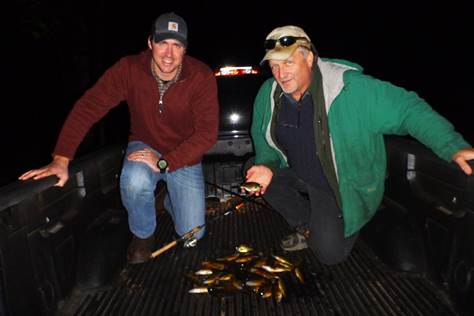
This is why the bag limits for bluegills are typically very liberal – it is not unusual to be able to keep 25 fish a day. It’s the angler’s duty to catch and eat as many as possible – keep the herd in check, if you will.
It sounds good, but current research suggests it’s wrong.
In fact, research conducted by Andrew Rypel, research biologist with the Wisconsin Department of Natural Resources, suggests the opposite: that liberal harvest limits on bluegills actually decreases the size of fish.
“Fish Here Aren’t As Big As They Used to Be”
Bluegills are often the first fish many anglers encounter (including me). They are common in farm and urban ponds. They’re the fish kids catch with a Mickey Mouse rod, a bobber and worms.
In the spring, many anglers target them on their spawning beds, where the biggest males are often easy to catch (see yesterday’s blog for the full details on this spectacle).
Bluegills are also popular because they’re tasty. Anglers call them and similar-sized species – crappies, perch, other sunfish – panfish. They’re the perfect size to fit in a frying pan.
Rypel and his colleagues in Wisconsin noticed something over the years: Anglers reported decreasing size of bluegills and other panfish. Of course, conventional angling wisdom would suggest the solution to this would be to harvest even more bluegills. After all, decreasing size is a sign of overpopulation.
Research tells a different story.
Rypel analyzed size trends going back to the 1940’s, and found that bluegills (and other panfish species) steadily declined in size over a 70-year period.
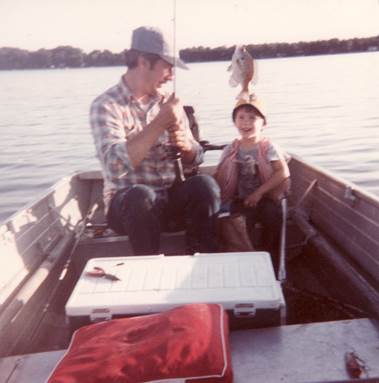
“The regulations are relatively liberal,” he says. “I thought one possibility might be that we were fishing them too hard. As we looked at the data, we found that evidence of bluegills becoming stunted because they were overpopulated was not as common as previously thought.”
Fishing pressure, particularly on spawning beds where bluegills are most vulnerable, can be intense. And that pressure may be decreasing the size of fish.
In response to the trend, the Wisconsin DNR reduced the bag limit to 10 fish on 10 lakes as a test. Researchers, including Rypel, analyzed fish size before and after the regulation.
They found that fish size increased on average a half-inch on maximum size and .8 inch on mean size.
That may not sound like much, but consider that a typical bluegill is six or seven inches, and a really large one is ten inches.
Rypel published the findings in the North American Journal of Fisheries Management.
A New Experiment in Bluegill Management
The next phase of the project is to implement new management strategies on 100 Wisconsin lakes. One third will have a reduced limit of 10, one third will have a reduced limit of 5, and one third will have a reduced bag limit only during the spawning season.
The management regimes will run for ten years. “We’re going to find out what different regulations can do for panfish size,” says Rypel.
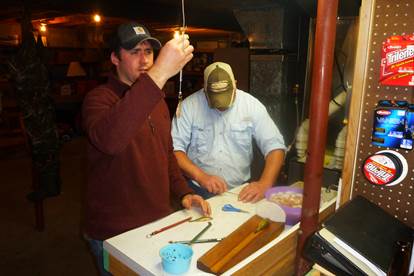
The good news is that bluegill size rebounds when fishing pressure decreases. A study by Rypel in collaboration with researchers at the University of Wisconsin-Milwaukee, School of Freshwater Sciences found that the reduction in size was not likely due to a shift in genetics, as has been shown to be the case in some other prominent studies on fishing pressure.
Anglers have, in general, been reluctant to embrace size limit reductions. Rypel points out that the limit reductions may actually result in more meat harvested. That may seem counterintuitive, but it’s true. “As bluegills get bigger in length, they get exponentially bigger in weight,” he says. “So if you catch a few larger bluegills, you often get more meat than if you caught a bunch of smaller ones.”
There is still a lot biologists don’t know about bluegills. New research will likely call for more changes in fishing regulation, but Rypel acknowledges that science is only one part of fisheries regulation.
“Regulations are a blunt instrument,” he says. “They cannot account for all aspects of fisheries management. If they get too complicated, they become much more difficult to enforce. We want regulations that are easy to understand and easy to enforce. There are trade-offs. In this case, reducing the bag limit could help the resource tremendously while still meeting the expectations of anglers.”
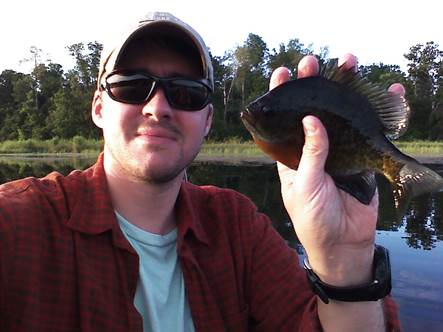
And while the bluegill may seem an unlikely symbol for global fisheries management, what Rypel says applies to large commercial fisheries as surely as it does the local farm pond. Regulations are only ever partly about science, and they can never fully account for the complexity of a fishery.
The key for resource managers is to use sound science to create regulations that work best – for fish and for people.
“Bluegills have the opportunity to get bigger with a relatively minor shift in fishing regulations,” says Rypel. “Our research is providing the evidence that it benefits anglers, too. The findings seem counter-intuitive to many anglers, who have long believed that smaller bluegills was a sign of overpopulation. But perhaps our long-term studies can convince them that lower bag limits can mean better fishing, and bigger panfish fillets for the fish fry.”
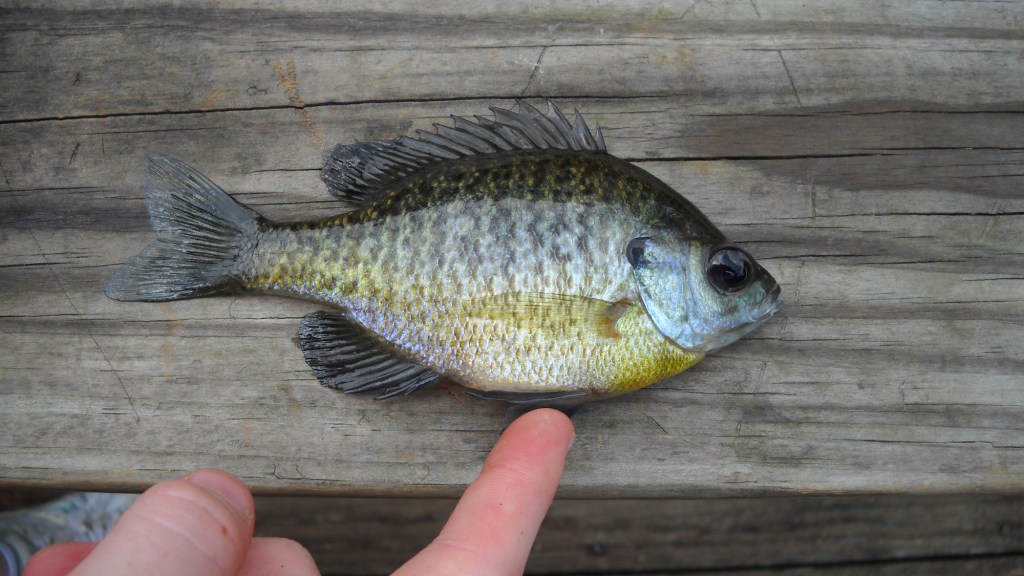



In a commercial fish rearing venture what specifically are bluegills fed?
Everything I’ve read here says imposing a size limit to your bag would increase size and quality. No one looks at bream like bass fishing. It’s a catch everything and conserve nothing mentality. A slot limit with an over size take limit would probably do The species better. There’s also the panfishers out there that target the huge ones and throw back the “good eating size” and that depleted the older larger ones. These guys know there stuff and use it well. I see it with the crappie guys too.
I believe this to be accurate and factual information. Especially when dealing with small bodies of water
I will soon have a pair of hybrid cichlids called the (RED PHOENIX KING CICHLIDS?) they’re south and central america mixed the male grows up to a large 28 inches the female 20″ they are extremely extremely extremely extremely extremely aggressive/territorial/quarrrelsome and predatory they will rule the tank. I will add citizen cichlids like 4 firemouth cichlids with houses for hiding and 2 cluwn loach catfish. On the far Right side of the tank it will be dark with red coral trees and a cave with 1 single bull male bluegill sunfish.
To what extent does it matter whether bluegills and other sunfish are native fish with natural predators as opposed to introduced fish – such as in California? After all, bluegills are capable of laying 50,000 eggs and without natural predators, it seems logical that they would overpopulate a pond or lake depending on the food supply. Granted, black bass are often introduced into the same waters as bluegills, providing predators. However, many other natural predators such as wading birds, otters, and turtles may not be present.
Thank you for sharing this research. My wife and I bought a small condo in central Indiana with a retention pond right off the patio. I have been fishing it almost every day all spring and summer. One of the first fish I caught was a 12-inch bluegill, the biggest I have ever caught — anywhere! After that, most of the bluegills I catch are five to eight inches, with a couple of nine-inchers nearly every week. This made me wonder . . . Why do the bluegills in our pond run bigger than the ones I catch at Lake Monroe (Indiana)?
Perhaps the bluegill in this pond run bigger and are so easy to catch (on flies, worms, hot dogs, dough, bacon, jigs, etc.) simply because our pond hasn’t been fished very much. I make it a point to keep only three to six bluegills each week, as I agree with your assessment of the state of the species in our State, and I am the only person in the family who eats them.
Fyi, I catch one or two green sunfish and/or largemouth bass each week, too. I have seen only one catfish in our pond. I caught him twice. He is about 24 to 28 inches long. I have caught only one crappie in the six months I have fished this pond.
The 5 fish limit imposed on one of my favorite lakes is working. I have caught and released more 9 inch gills this year than ever before . Just yesterday, four 9 inchers. I’m averaging 7-8 inch fish per 5 fish limit. There is very little fishing pressure as I only encounter 2-3 boats at a time. I like catching bigger fish instead of more smaller fish.
Why not create some new spawning beds? I suspect new beds with brush nearby would increase the survival rate of the young as well as make it harder to fish the beds giving the big gills a better chance of surviving.
WHat do you do if your bluegill looks like its sleeping and its gills are moving but you think its dead.
I am a retired fishery biologist with many years of experience in the southeastern U.S. In our part of the country, it is not unusual for managed ponds to become overcrowded with stunted bluegills. Correcting this situation can be risky (“partial poisoning”) or expensive (“corrective restocking” with bass in the 6-inch to 8-inch sizes). Often the problem is so severe as to be “corrected” only by poisoning out the fish populations and starting over.
I believe this problem in more common in our region than in points further north because of the longer spawning season for bluegills. Largemouth bass get off a single annual spawn; bluegills can spawn several times, more often in the South than in areas farther north. It stands to reason that these differences induce more frequent overcrowding by bluegills in the South.
When it becomes obvious that overcrowding is under way, EVERY undersized bluegill caught should be permanently removed from the pond–show no mercy. What is “undersized”? Well, if a fish is too small to clean, cook and eat, it should be regarded as undersized, whether actually stunted or not (stunted fish are underweight and have disproportionately large eyes). Concurrently, it is good practice NOT to remove adult bass for a while. They need to remain in the pond to prey on the abundant undersized bluegills. Irrespective of these practices, the ultimate remedy, most often, is to poison and restock, although partial poisoning can be tried first–preferably with assistance from a professional with experience in that practice.
do some fun facts on them
I am doing a school project on how we can protect the Bluegill… I have alot of information already, but does anyone have anything they think I should add, that isn’t on this website? Thanks so much!
There may be some truth in this. Other factors must also be considered. The amount of minnows in many lakes has changed with the planting of game fish at larger sizes and resulting more game fish in the water. This can correlate to the over fishing and cherry picking that anglers are being blamed for. Fish behavior can also affect how well they grow. When there is too much danger of being attacked by a game fish with teeth feeding can be considerably curtailed. Often the food supply for bluegills is like a pasture that is over grazed and lacks productivity. If bluegill are held to a small range by game fish that may happen. Also fish grow the best when they can eat freely, because for some reason individuals like to specialize in what they eat. Sometimes bluegills developed dense schooling behavior to deal with the fear of game fish, but this puts any odd fish in danger because game fish can keep his eye on an individual in an attack. This may make larger individuals a game fish mark. The level of game fish in lakes does come at a price when the preferred food of oily fish and minnows are gone. Many good bluegill lakes are greatly reduced by the unnatural population increase of game fish which can add even more fishing pressure to other great bluegill waters. Virtual no lakes are managed for only the bluegills. It is never mentioned how very large panfish eat very small panfish thinning there numbers, helping to control the over feeding of the immature food supply of larger bluegill. That is why cherry picking might not help overall sizes. I could go on but i have only touched the iceberg because it has so many variations of what can go wrong.
It has also been proven where there is the combination of Largemouth Bass and bluegill, the population of the gills are kept down and the fish have more food and get bigger. A larger limit of fish also will take more fish out of the lake to increase size of the remaining. If there is intense fishing pressure on a lake there will be less bluegills but the size will increase also. Restricting the season till after spawning is complete may increase the size also.
I thought it was common knowledge now what the dynamics behind this are. Maybe I should say, are speculated to be – who knows for sure. Simple really. There are two factors at work. Fish tend to grow a lot faster before reaching sexual maturity. Once old enough to spawn, they put energy into that process, rather than body growth. And may eat less as well since they are occupied with spawning much of the time. The second factor is once they reach sexual maturity, the rigors of spawning, and maybe just some biological time clock also, dictate they will soon die. So, the sooner a bluegill reaches sexual maturity, the sooner it’s growth will slow. And the shorter its life span.
Now take a lake with a certain amount of desirable spawning habitat. A population of 5 year old, 9 to 10 inch bluegills, that control the spawning activity. Remove 80 percent of them, and 4 year old fish begin to fill the vacuum. Nature, in its wisdom, has made younger fish mature at an earlier age. The dominance of the bigger 5-year olds had kept the 4-year olds fast-growning juvies, but are no longer around to do that. Now you have a lake full of 4-year old bluegills that have practically stopped growing. Pretty simple idea really. Is it true? I don’t know, but many biologists have bought into it.
Very disappointing to see so many comments like “common sense dictates more fish will mean smaller fish”. Only in a very simple system with limited food supply and not subject to the confounding factors nature throws our way all the time.